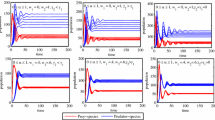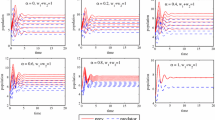Abstract
To understand roles of fuzzy biological parameters, in this paper, we propose a fuzzy predator–prey harvesting model that incorporates both the effects of prey refuge and predator mutual interference. Using the triangular fuzzy numbers for the imprecise parameters, we first study the existence of the feasible equilibria and their global stability and then discuss the bionomic equilibrium and the possible optimal harvesting policy. Numerical simulations are carried out to illustrate our analytical results, based on which discussions and conclusions are made. They show that the fuzziness of biological parameters can greatly affect the dynamics of the ecological system.










Similar content being viewed by others
References
Hassell, M.P.: Mutual interference between searching insect parasites. J. Anim. Ecol. 40, 473–486 (1971)
Freedman, H.I.: Stability analysis of a predator–prey system with mutual interference and density-dependent death rates. Bull. Math. Biol. 41, 67–78 (1979)
Lv, Y., Du, Z.: Existence and global attractivity of a positive periodic solution to a Lotka–Volterra model with mutual interference and Holling III type functional response. Nonlinear Anal. Real World Appl. 12, 3654–3664 (2011)
Sun, G., Wang, C., Chang, L., Wu, Y., Li, L., Jin, Z.: Effects of feedback regulation on vegetation patterns in semi-arid environments. Appl. Math. Model. 61, 200–215 (2018)
Shi, H., Ruan, S.: Spatial, temporal and spatiotemporal patterns of diffusive predator–prey models with mutual interference. IMA J. Appl. Math. 80, 1534–1568 (2015)
Liang, Z., Pang, G., Zeng, X., Liang, Y.: Qualitative analysis of a predator–prey system with mutual interference and impulsive state feedback control. Nonlinear Dyn. 87, 1495–1509 (2017)
Ma, Z., Li, W., Zhao, Y., Wang, W., Zhang, H., Li, Z.: Effects of prey refuges on a predator–prey model with a class of functional responses: the role of refuges. Math. Biosci. 218, 73–79 (2009)
Tao, Y., Wang, X., Song, X.: Effect of prey refuge on a harvested predator–prey model with generalized functional response. Commun. Nonlinear Sci. Numer. Simul. 16, 1052–1059 (2011)
Tang, G., Tang, S., Cheke, R.A.: Global analysis of a Holling type II predator–prey model with a constant prey refuge. Nonlinear Dyn. 76, 635–647 (2014)
Sun, G., Wu, Z., Jin, Z., Wang, Z.: Influence of isolation degree of spatial patterns on persistence of populations. Nonlinear Dyn. 83, 811–819 (2016)
Přibylová, L., Berec, L.: Predator interference and stability of predator–prey dynamics. J. Math. Biol. 71, 301–323 (2015)
Chen, L., Chen, F., Wang, Y.: Influence of predator mutual interference and prey refuge on Lotka–Volterra predator–prey dynamics. Commun. Nonlinear Sci. Numer. Simul. 18, 3174–3180 (2013)
Ma, Z., Chen, F., Wu, C., Chen, W.: Dynamic behaviors of a Lotka–Volterra predator–prey model incorporating a prey refuge and predator mutual interference. Appl. Math. Comput. 219, 7945–7953 (2013)
Zhao, W., Li, J., Zhang, T., Meng, X., Zhang, T.: Persistence and ergodicity of plant disease model with markov conversion and impulsive toxicant input. Commun. Nonlinear Sci. Numer. Simul. 48, 70–84 (2017)
Bao, J., Shao, J.: Permanence and extinction of regime-switching predator–prey models. SIAM J. Math. Anal. 48, 725–739 (2016)
Li, D., Liu, S., Cui, J.: Threshold dynamics and ergodicity of an SIRS epidemic model with Markovian switching. J. Differ. Equ. 263, 8873–8915 (2017)
Dang, H.N., Yin, G.: Coexistence and exclusion of stochastic competitive Lotka–Volterra models. J. Differ. Equ. 262, 1192–1225 (2017)
Li, L., Wang, C., Wang, S., et al.: Hemorrhagic fever with renal syndrome in China: mechanisms on two distinct annual peaks and control measures. Int. J. Biomath. 11, 1850030 (2018)
Liu, M., Fan, M.: Permanence of stochastic Lotka–Volterra systems. J. Nonlinear Sci. 27, 425–452 (2017)
Liu, Q., Jiang, D.: Periodic solution and stationary distribution of stochastic predator–prey models with higher-order perturbation. J. Nonlinear Sci. 482, 1–20 (2017)
Zhao, Y., Yuan, S., Zhang, Q.: The effect of Lévy noise on the survival of a stochastic competitive model in an impulsive polluted environment. Appl. Math. Model. 40, 7583–7600 (2016)
Bassanezi, R.C., Barros, L.C., Tonelli, P.A.: Attractors and asymptotic stability for fuzzy dynamical systems. Fuzzy Sets Syst. 113, 473–483 (2000)
Barros, L.C., Bassanezi, R.C., Tonelli, P.A.: Fuzzy modelling in population dynamics. Ecol. Model. 128, 27–33 (2000)
Peixoto, M., Barros, L.C., Bassanezi, R.C.: Predator–prey fuzzy model. Ecol. Model. 214, 39–44 (2008)
Guo, M., Xue, X., Li, R.: Impulsive functional differential inclusions and fuzzy population models. Fuzzy Sets Syst. 138, 601–615 (2003)
Mahapatra, G.S., Mandal, T.K.: Posynomial parametric geometric programming with interval valued coefficient. J. Optim. Theory Appl. 154, 120–132 (2012)
Pal, D., Mahapatra, G.S.: Dynamic behavior of a predator–prey system of combined harvesting with interval-valued rate parameters. Nonlinear Dyn. 83, 2113–2123 (2016)
Zhang, X., Zhao, H.: Bifurcation and optimal harvesting of a diffusive predator–prey system with delays and interval biological parameters. J. Theor. Biol. 363, 390–403 (2014)
Sharma, S., Samanta, G.P.: Optimal harvesting of a two species competition model with imprecise biological parameters. Nonlinear Dyn. 77, 1101–1119 (2014)
Pal, D., Mahapatra, G.S., Samanta, G.P.: Stability and bionomic analysis of fuzzy prey–predator harvesting model in presence of toxicity: a dynamic approach. Bull. Math. Biol. 78, 1–27 (2016)
Puri, M.L., Dan, A.R.: Differentials of fuzzy functions. J. Math. Anal. Appl. 91, 552–558 (1983)
Clark, C.W.: Mathematical Bioeconomics: The Optimal Management of Renewable Resources. Wiley, New York (1976)
Pontryagin, L.S., Boltyanski, V.S., Gamkrelidze, R.V., Mishchenco, E.F.: Themathematical Theory of Optimal Processes. Wiley, New York (1962)
Wang, Q., Liu, Z., Zhang, X., Zhang, X., Cheke, A.: Incorporating prey refuge into a predator–prey system with imprecise parameter estimates. Comput. Appl. Math. 36, 1067–1084 (2017)
Funding
This study was funded by the National Natural Science Foundation of China (No. 11671260), Shanghai Leading Academic Discipline Project (No. XTKX2012) and Hujiang Foundation of China (B14005).
Author information
Authors and Affiliations
Corresponding author
Ethics declarations
Conflict of interest
The authors declare that they have no conflict of interest.
Appendices
Appendix A: Mathematical preliminaries
We introduce some results concerning fuzzy sets, triangular fuzzy number and utility function. For more details see [24, 30].
Definition 1
(Fuzzy subset) A fuzzy subset \(\widetilde{A}\) of a universal set X is defined by the set of pairs \(\widetilde{A}=\{(x, \mu _{\widetilde{A}}(x)): x\in X\}\), where the mapping \(\mu _{\widetilde{A}}: X\rightarrow [0, 1]\) is called the membership function and \(\mu _{\widetilde{A}}(x)\) gives to x its membership grade to the subset \(\widetilde{A}\).
We would like to point out that a classic subset A of X is a special fuzzy set, where the membership function is replaced by characteristic function of A, \(\chi _A: X\rightarrow \{0, 1\}\).
Definition 2
(\(\alpha \)-cut of fuzzy subset) Let \(\mathscr {F}(X)\) indicates the family of fuzzy sets in X. For any \(\widetilde{A}\in \mathscr {F}(X)\) and \(\alpha \in (0, 1]\), a crisp set
is called \(\alpha \)-cut of fuzzy set \(\widetilde{A}\). Here, \(\alpha \) is called the confidence level. For \(\alpha =0\), \(A_0\) is defined as \(A_0=\overline{\{x\in X: \mu _{\widetilde{A}}(x)>0\}}\).
Clearly, \(\alpha \)-cut of fuzzy subset is a classical set, which determines the clear attribution of an element to a fuzzy subset. Therefore, Definition 2 provides a method to convert a fuzzy subset into a classical set.
Definition 3
(Fuzzy number) Let \(\widetilde{A}\) be the fuzzy set on the real number set \(\mathbb {R}\), i.e., \(\widetilde{A}\in \mathscr {F}(\mathbb {R})\). Then the fuzzy set \(\widetilde{A}\) is called a fuzzy number if it has the following properties:
-
(i)
\(\widetilde{A}\) is a normal fuzzy set, i.e., there exists a \(x\in \mathbb {R}\) such that \(\mu _{\widetilde{A}}(x)\equiv 1\);
-
(ii)
\(\widetilde{A}\) is a convex fuzzy set, i.e., for all \(\alpha \in [0, 1]\), the \(\alpha \)-cut set \(A_{\alpha }\) is a closed bounded interval.
Remarkably, let \(\widetilde{A}\in \mathscr {F}(\mathbb {R})\), the \(\alpha \)-cut set \(A_{\alpha }\) can be described by \(A_{\alpha }=[A_L^{\alpha }, A_R^{\alpha }]\), where \(A_L^{\alpha }=\inf \{x\in \mathbb {R}: \mu _{\widetilde{A}}(x)\ge \alpha \}\) and \(A_R^{\alpha }=\sup \{x\in \mathbb {R}: \mu _{\widetilde{A}}(x)\ge \alpha \}\).
Definition 4
(Triangular fuzzy number (TFN)) Let \(a_1\), \(a_3\) and \(a_2\) denote, respectively, the lower bound, the upper bound and the maximum possible value of a fuzzy number, then the fuzzy number \(\widetilde{A}=(a_1, a_2, a_3)\) is called a TFN, where the membership function \(\mu _{\widetilde{A}}: \mathbb {R}\rightarrow [0, 1]\) is defined as follows:
It is clear from definition 4 that \(\alpha \)-cut of TFN \(\widetilde{A}=(a_1, a_2, a_3)\) is a closed and bounded interval \([A_L^{\alpha }, A_R^{\alpha }]\), where
We now list some arithmetic operations on fuzzy numbers.
Lemma 1
If \(\widetilde{A}, \widetilde{B}\in \mathscr {F}(\mathbb {R})\), then for all \(\alpha \in (0,1]\), the following conclusions are valid.
-
(i)
\([\widetilde{A}+\widetilde{B}]_{\alpha }=[A_L^{\alpha }+B_L^{\alpha }, A_R^{\alpha }+B_R^{\alpha }]\);
-
(ii)
\([\widetilde{A}\cdot \widetilde{B}]_{\alpha }=\Big [\min \{A_L^{\alpha }B_L^{\alpha }, A_L^{\alpha }B_R^{\alpha }, A_R^{\alpha }B_L^{\alpha }, A_R^{\alpha }B_R^{\alpha }\}, \max \{A_L^{\alpha }B_L^{\alpha }, A_L^{\alpha }B_R^{\alpha }, A_R^{\alpha }B_L^{\alpha }, A_R^{\alpha }B_R^{\alpha }\}\Big ]\);
-
(iii)
\([\widetilde{A}-\widetilde{B}]_{\alpha }=[A_L^{\alpha }-B_R^{\alpha }, A_R^{\alpha }-B_L^{\alpha }]\).
Finally, we give a method called the utility function, which plays a critical role in building our model. A utility function is usually defined according to the relative importance of the objective \(h_i\). Let \(\varpi _i\) denote the weight assigned to the ith objective, then a simple utility function of the ith objective can be defined as \(\varpi _ih_i\). Thus, the total utility may be expressed by
where \(\sum \nolimits _{i=1}^l\varpi _i=1\). Obviously, the total utility is the weighted sum of all objectives.
Appendix B: Analysis the effects of \(\theta \) and m on predator–prey species
Suppose model (6) exists a unique interior equilibrium \(M^*(x^*,y^*)\), then we have
Furthermore,
which implies that \(H>0\), for any \(0<\theta \le 1\) and \(0\le m<1\). Thanks to the existence theorem of implicit function, equation (40) determines two implicit functions as follows: \(x^*=x^*(\theta ,m), y^*=y^*(\theta ,m).\) After some simple calculations, we have
We then have the following conclusions:
-
(a)
\(x^*(\theta )\) is strictly increasing if \(0<y^*<1\); \(x^*(\theta )\) is strictly decreasing if \(y^*>1\);
-
(b)
\(y^*(\theta )\) is strictly increasing if \(x^*>\frac{a-q_1E_1}{2b}\) and \(y^*>1\) (or \(0<x^*<\frac{a-q_1E_1}{2b}\) and \(0<y^*<1\)); \(y^*(\theta )\) is strictly decreasing if \(x^*>\frac{a-q_1E_1}{2b}\) and \(0<y^*<1\) (or \(0<x^*<\frac{a-q_1E_1}{2b}\) and \(y^*>1\));
-
(c)
\(x^*(m)\) is strictly increasing for all \(0\le m<1\);
-
(d)
\(y^*(m)\) is strictly increasing if \(0<x^*<\frac{a-q_1E_1}{2b}\); \(y^*(m)\) is strictly decreasing if \(x^*>\frac{a-q_1E_1}{2b}\).
Rights and permissions
About this article
Cite this article
Yu, X., Yuan, S. & Zhang, T. About the optimal harvesting of a fuzzy predator–prey system: a bioeconomic model incorporating prey refuge and predator mutual interference. Nonlinear Dyn 94, 2143–2160 (2018). https://doi.org/10.1007/s11071-018-4480-y
Received:
Accepted:
Published:
Issue Date:
DOI: https://doi.org/10.1007/s11071-018-4480-y




